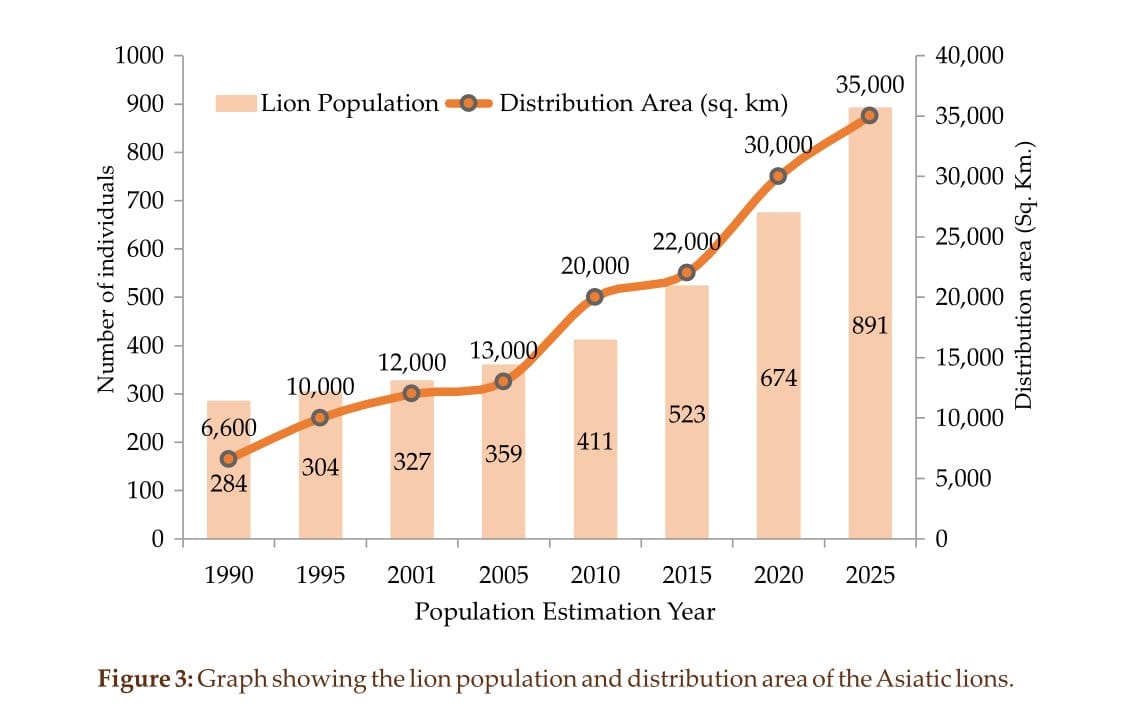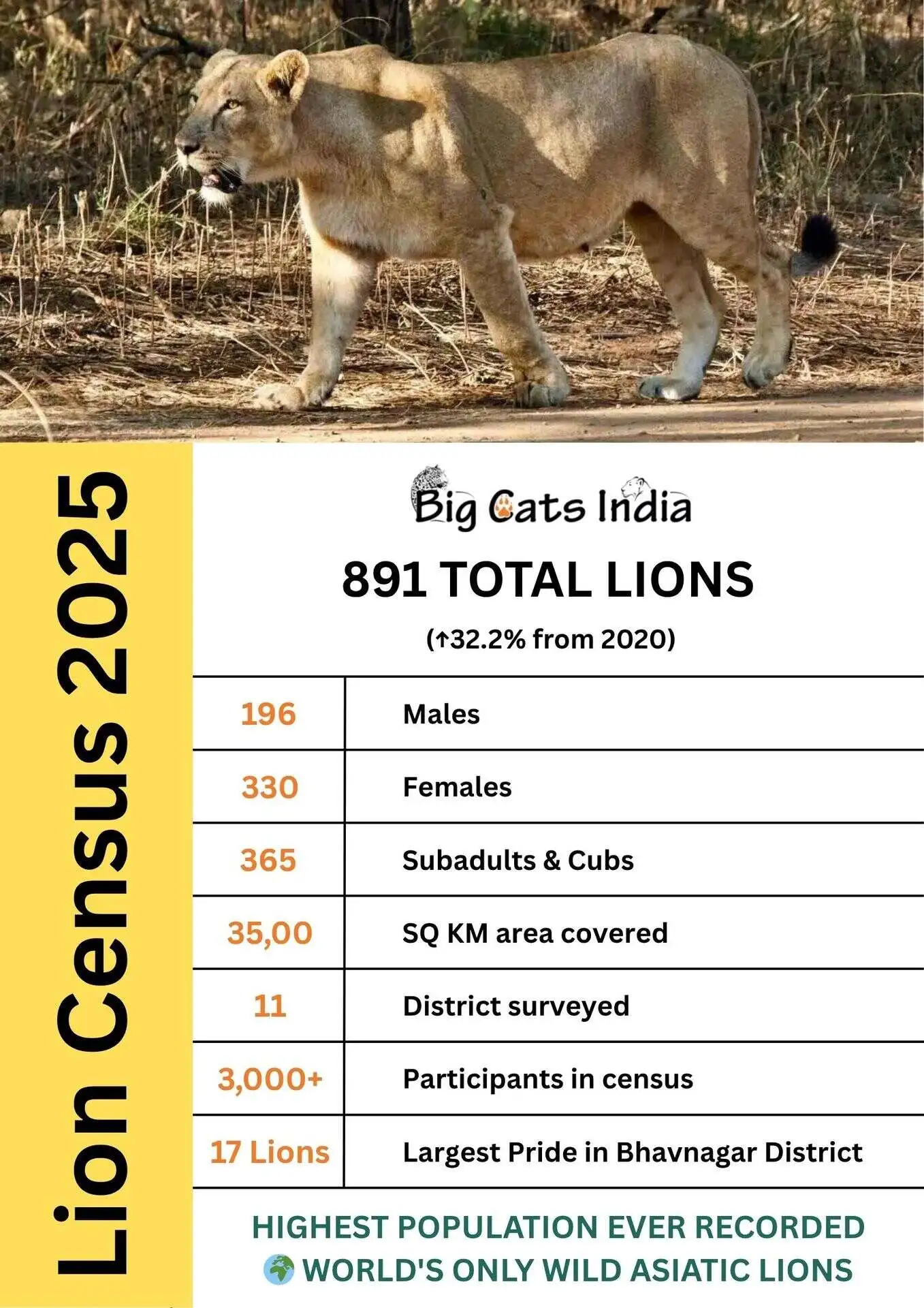The Lion’s Roar Returns: How India's Project Lion Saved the Asiatic Kings from Extinction
India’s Asiatic lion population has hit a record high of 891, a stunning 32% increase since 2020. The Asiatic lion's comeback is not just a triumph for Gujarat but a blueprint for global wildlife conservation.

Written by Lavanya, Intern, Allegedly The News
Sasan Gir, Gujarat, August 12, 2025
A Roaring Comeback: From 674 to 891
In a truly remarkable announcement on World Lion Day 2025, Gujarat Chief Minister Bhupendra Patel declared that the state’s Asiatic lion population had reached an unprecedented 891 individuals. This figure, a dramatic jump from the 674 lions counted in the 2020 census, signifies a 32.2% growth in just five years. The latest census, conducted from May 10 to 13, 2025, across a vast 35,000 sq km area, is a powerful testament to the success of “Project Lion,” a flagship conservation program launched by Prime Minister Narendra Modi on August 15, 2020.
The journey of the Asiatic lion has been one of survival against all odds. By the beginning of the 20th century, their numbers had dwindled to fewer than 50 individuals, confined to the Gir Forest. A century later, India has not only pulled them back from the brink but has set them on a path of sustained recovery. This report dissects the multifaceted conservation measures that have fueled this population boom, examines India’s role as a global conservation leader, and looks ahead to the challenges and opportunities that will define the species' future.
The Engine of Success: Deconstructing Conservation Measures
The recent population census is not merely a number; it’s a reflection of a meticulously planned and executed strategy. Project Lion is built on a framework of scientific management, technological innovation, and community inclusion.
The Greater Gir Vision: Expanding the Kingdom
A critical component of Project Lion is the "Greater Gir" concept. Recognizing that the core Gir National Park alone cannot sustain a perpetually growing population, the strategy has been to expand the lion’s habitat. This has involved the creation of new protected areas and the development of safe corridors for the lions to disperse naturally.
The 2025 census revealed a significant milestone: lions are no longer restricted to the traditional Gir-Girnar region. They have established new, stable satellite populations in areas like Barda Wildlife Sanctuary, Jetpur, Babra-Jasdan, and other parts of Saurashtra. The most recent count identified 497 lions residing in these satellite populations across nine locations. For the first time, 22 lions were also recorded within the corridors connecting these habitats, a clear sign that the expansion strategy is bearing fruit. This natural dispersal is vital for genetic diversity and reduces the risk of a single catastrophic event, like a disease outbreak, from decimating the entire population. The government’s recent allocation of land at New Pipliya in Junagadh for a National Referral Centre for wildlife healthcare is a direct response to this need for better disease management.
Technology and Data-Driven Protection
Modern conservation is no longer just about foot patrols; it's about leveraging technology to monitor and protect. The 2025 census itself was a technological marvel, utilizing GPS-enabled devices, camera traps, radio collars, and an AI-based software to identify individual lions. This data-driven approach allows for real-time monitoring of lion movements, health, and social dynamics.
The use of the SMART (Spatial Monitoring and Reporting Tool) patrolling system has empowered forest rangers with a scientific framework to conduct their patrols more effectively. This system helps identify threats, track human-wildlife conflict zones, and analyze wildlife populations with unprecedented accuracy. The integration of technology has transformed conservation from a reactive measure into a proactive, evidence-based science.

Human-Wildlife Coexistence: The People's Project
The success of Project Lion would be impossible without the cooperation of the local communities. For decades, the Maldhari pastoralists have coexisted with the lions, a unique relationship that has become a global model for human-wildlife harmony. Project Lion has built on this foundation by formalizing community engagement.
The new funding plan includes significant allocations for community development, including a more robust compensation scheme for livestock depredation. By ensuring that the economic impact of living with lions is mitigated, the government has turned potential adversaries into powerful conservation allies. The local communities, including sarpanches and villagers, were an integral part of the 2025 census, actively participating in the counting process, a testament to their deep-rooted pride and sense of ownership over the lions.
India’s Global Conservation Leadership: A Tale of Two Continents
India’s success with the Asiatic lion has placed it at the forefront of global wildlife conservation. A comparison with African lion programs reveals a unique and highly effective model.
The Gir Model vs. African Programs
While Africa is home to the vast majority of the world's lions, many populations are declining due to a complex web of threats, including habitat fragmentation, trophy hunting, and retaliatory killings. Conservation efforts are often decentralized and face political and social challenges across multiple nations.
India’s approach to the Asiatic lion is different. It is a single, national effort focused on a single species in a defined landscape. The complete ban on hunting, combined with strong legal protections and a centralized policy under the Ministry of Environment, Forest, and Climate Change, provides a clear and consistent framework. The Gir model, where a dense human population lives in close proximity to the lions, offers a blueprint for coexistence that many other nations are now studying. The recent launch of the International Big Cat Alliance (IBCA) by India to foster global cooperation is a recognition of this leadership, allowing India to share its expertise and conservation strategies with 97 other big cat range countries.
Investing in the Future: Government Funding and Goals
The future of the Asiatic lion is being secured with a substantial new financial commitment from the government. The Ministry of Environment, Forest, and Climate Change has sanctioned a colossal 10-year budget of ₹2,927.71 crore for Project Lion.
Key Goals and Allocations
This monumental funding is not just for lion protection; it's a holistic plan for the entire ecosystem and the people who depend on it. Key goals include:
- Veterinary and Health Infrastructure: The establishment of the National Referral Centre for wildlife healthcare in Junagadh, with 20.24 hectares of land, is a cornerstone of this plan. It will serve as a state-of-the-art facility for disease diagnostics and treatment, safeguarding the population from future epidemics like the Canine Distemper Virus (CDV) outbreak of 2018.
- Habitat Restoration and Prey Base Management: A significant portion of the funds will be used for afforestation and creating new water sources within the expanded lion habitat. This will improve the prey base, ensuring a stable food supply for the growing lion population and reducing their need to hunt livestock outside the protected areas.
- Ecotourism and Local Economy: A new safari park and tourist facilities, costing ₹75 crore, are planned for the Barda Wildlife Sanctuary. This initiative will not only generate revenue for conservation but also create livelihoods for local communities, turning them into direct beneficiaries of the lions' existence. The expansion of ecotourism into new areas will also help to disperse the tourism pressure from the over-burdened Gir National Park.
A Historical Turning Point: Reversing the Decline
The story of the Asiatic lion is a dramatic narrative of decline and recovery, a testament to the power of human intervention.
The Brink of Extinction and a Princely Decree
In the late 19th and early 20th centuries, the Asiatic lion was a prime target for trophy hunters from the British Raj and Indian royalty. Their numbers plummeted to a critical low, confined to a small, fragmented patch of forest. The turning point came with the compassionate foresight of the Nawab of Junagadh, who, at the urging of Lord Curzon, placed a total ban on lion hunting in his state. This singular act of protection was the first domino to fall in the long, arduous journey of the lion’s recovery.
Gir’s Rise as a Sanctuary
Following India's independence, the Gir Forest was declared a wildlife sanctuary in 1965, providing the lions with a formal, legally protected haven. Subsequent policies, including the relocation of human settlements from the core area, allowed the forest to regenerate and the lion population to begin its slow but steady climb. The Gir ecosystem, with its diverse flora and abundant prey base of chital, sambar, and wild boar, proved to be the perfect sanctuary for the species to thrive.

The Challenges on the Horizon: A Cautious Optimism
While the population figures are cause for celebration, conservationists remain cautiously optimistic. The success of Project Lion brings with it a new set of challenges that must be addressed for long-term sustainability.
The Relocation Imperative
The single greatest threat to the Asiatic lion remains its status as a single, geographically isolated population. A natural disaster, a new epidemic, or a widespread forest fire could still wipe out the entire species. The Supreme Court of India's directive to relocate a founder population to Kuno National Park in Madhya Pradesh remains a critical, albeit politically contentious, goal. While the Gujarat government has focused on expanding the lion's range within the state, a second, isolated population is the only true long-term insurance policy against extinction. The success of the Barda Sanctuary as a "second home" for lions within Gujarat is a positive development, but it does not fully address the genetic and demographic risks associated with a single metapopulation.
Human-Wildlife Conflict and Climate Change
As the lion population expands its territory, instances of human-wildlife conflict are an increasing concern. The management of this conflict, especially in new dispersal areas, will be crucial. The government’s focus on robust compensation schemes and awareness campaigns is a good start, but constant vigilance and adaptability will be required. Furthermore, climate change poses an existential threat to the delicate Gir ecosystem. The frequency of extreme weather events like cyclones and droughts could alter the habitat, affecting the prey base and water sources. A comprehensive plan for climate change adaptation is an essential part of securing the lions' future.
Ethical Photography: A Call to Consciousness
As tourism surges in Gir and its new satellite areas, the role of photographers and visitors becomes more critical than ever. Ethical wildlife photography is a form of conservation in itself.
Respecting the Subject
- The Rule of the Road: Always stay in your vehicle and on designated safari paths. Do not attempt to get closer to the animals.
- Silence is Golden: Loud noises, shouting, or playing music can distress the lions and other wildlife. Maintain silence to observe them in their natural state.
- No Flash: Never use a flash, especially at night. It can be disorienting and harmful to the animals.
- Support Local: Hire local guides who are trained by the forest department. Their knowledge is invaluable, and your support contributes directly to the local economy and conservation efforts.

A Future Beyond Gir? The Global Blueprint
The remarkable comeback of the Asiatic lion is a powerful case study for conservation worldwide. The strategies employed in India are not just for one species; they are a blueprint for how a nation can turn the tide for its endangered fauna. From Project Tiger to the successful reintroduction of cheetahs, India has demonstrated a model of conservation that combines political will, scientific rigor, and community inclusion. This model holds valuable lessons for other countries struggling with human-wildlife conflict and shrinking habitats. The Asiatic lion's roar is now an anthem of hope, inspiring a new generation of conservationists.
The Roaring Question: What Will We Do Next?
With the Asiatic lion population thriving, how can we leverage this success to secure a second, genetically distinct population in Kuno National Park, and what political and social frameworks are needed to overcome the past hurdles?
Sources
Press Information Bureau (PIB), The Times of India, CMO Gujarat, Gujarat Forest Department, Lion Census 2025 Summary, Government of India, Ministry of Environment, Forest, and Climate Change / Asiatic Lion Census 2025 report, and other verified reports from the Ministry of Environment, Forest, and Climate Change.




